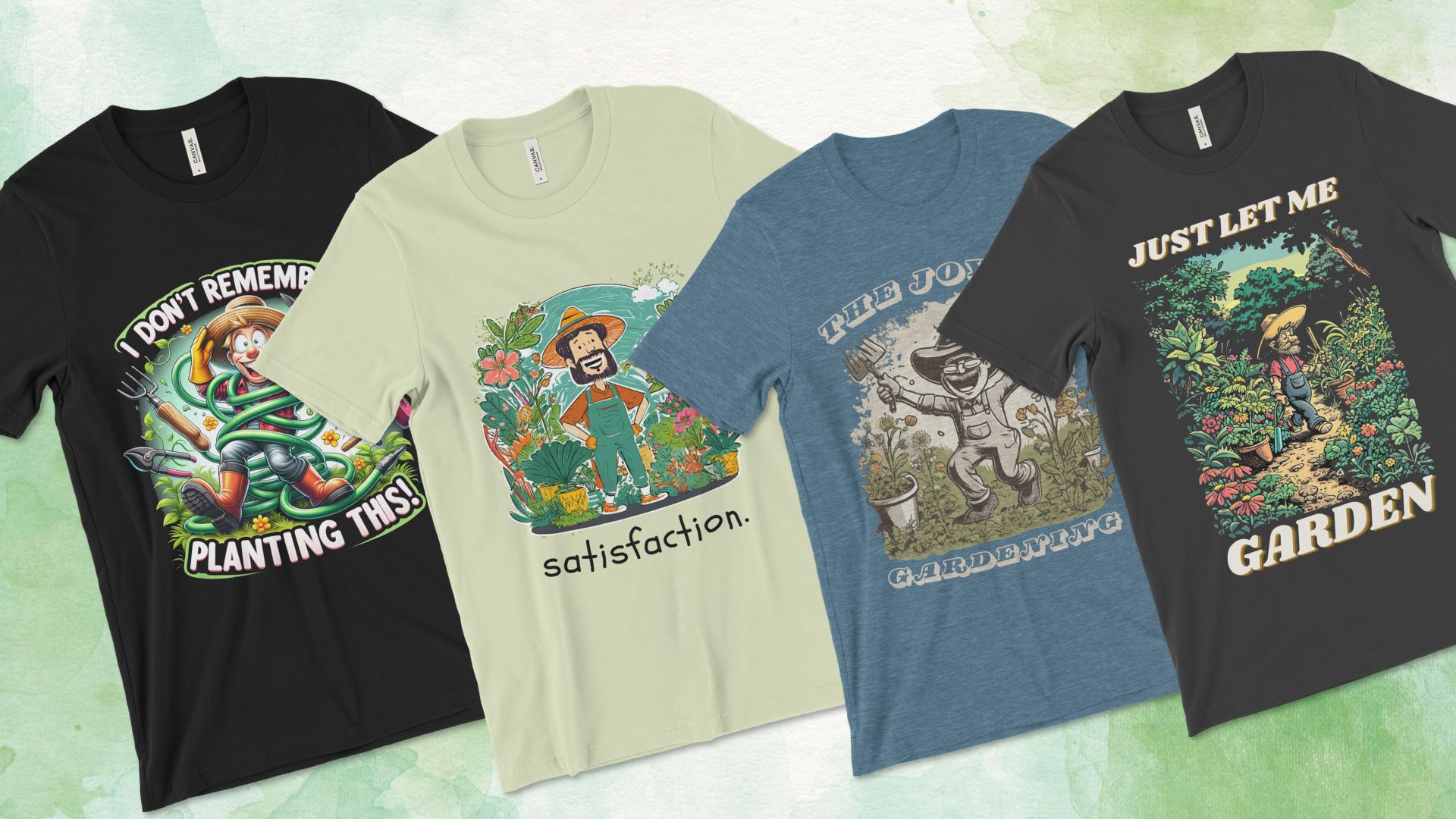AI-driven image generation enables those of us without artistic backgrounds to craft stunning, marketable visuals perfect for merchandise like t-shirts, mugs, tote bags, and pillows. This completely changes the creative process, which historically required hiring skilled artists or learning art from the ground up. Now, creators can produce commercial designs through simple textual prompts in text-to-image models.
However, as print on demand stores that leverage AI-generated artworks flourish, the bar for quality and uniqueness is continually being raised. This makes the choice of the image generator a critical factor in the design process.
To see how the big players compare, I spent some time creating various print on demand suitable graphics with the following image generators:
- Dall-E 3 (OpenAI’s art generator, available in ChatGPT Plus)
- Midjourney (hugely image generator from an independent research lab)
- DreamStudio (Stability AI’s own commercial interface for Stable Diffusion)
- Adobe Firefly v2
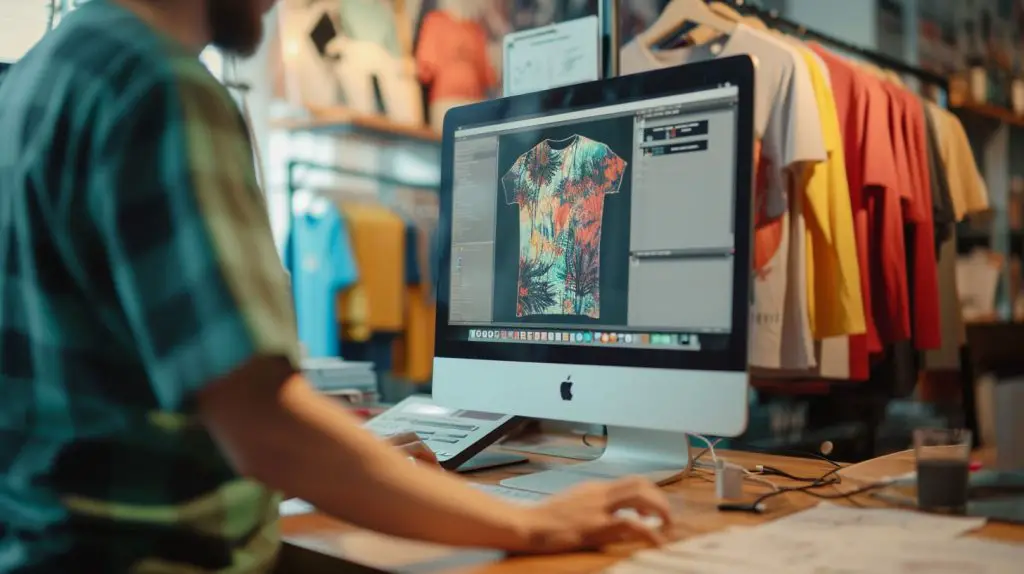
While numerous other commercial image generators exist, they generally utilize one of these major four text-to-image models, and merely add more user-friendly interfaces and pre-set prompts.
To keep things as controlled as possible, I made sure to prompt in a way that would yield the the most comparable outputs across these platforms. My goal was to ensure that the AI models were generating images closely aligned with my vision, rather than merely producing aesthetically pleasing but irrelevant visuals.
Note that it’s not always best to try and force an AI image generator to produce exactly what you want. Oftentimes, they’re just not capable of it. Sometimes its better to work in reverse and see what kind of stuff the AI comes back—prepare to be surprised, disappointed, or amused!
A note on text in graphics
If you’re new to image generators, you must know that AI image generators are no good when it comes to including text in the image. Words will be jumbled, misspelled, or just completely nonsensical.
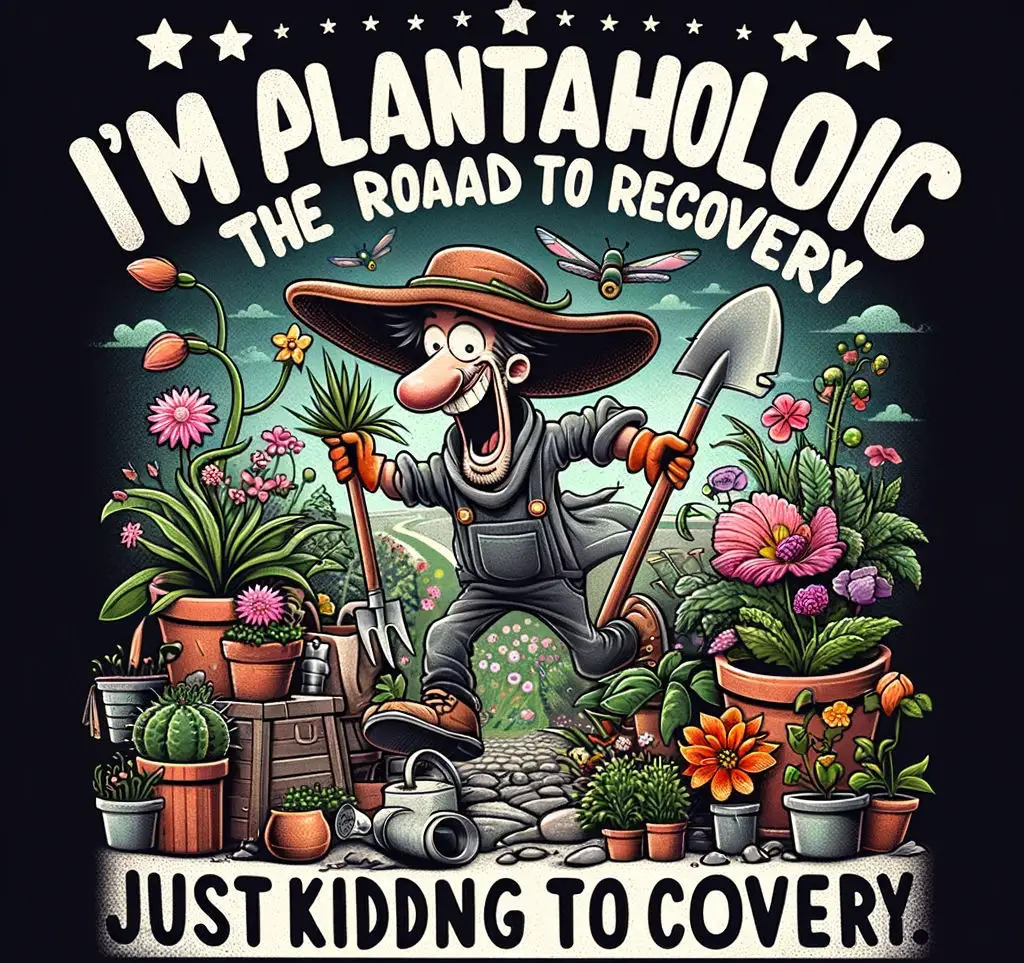
As a result, all the text in the designs were added afterwards by myself, with the exception of images generated by OpenAI’s Dall-E 3 (which is significantly better with text, but still far from perfect).
With time, I expect all these models to improve at drawing text. Not long ago they’d struggle to draw hands, often producing hands with too many or too few fingers, but the current situation is much better.
1. “Happy Camper”
The first design is aimed at campers, depicting a happy camper outside his camping van.
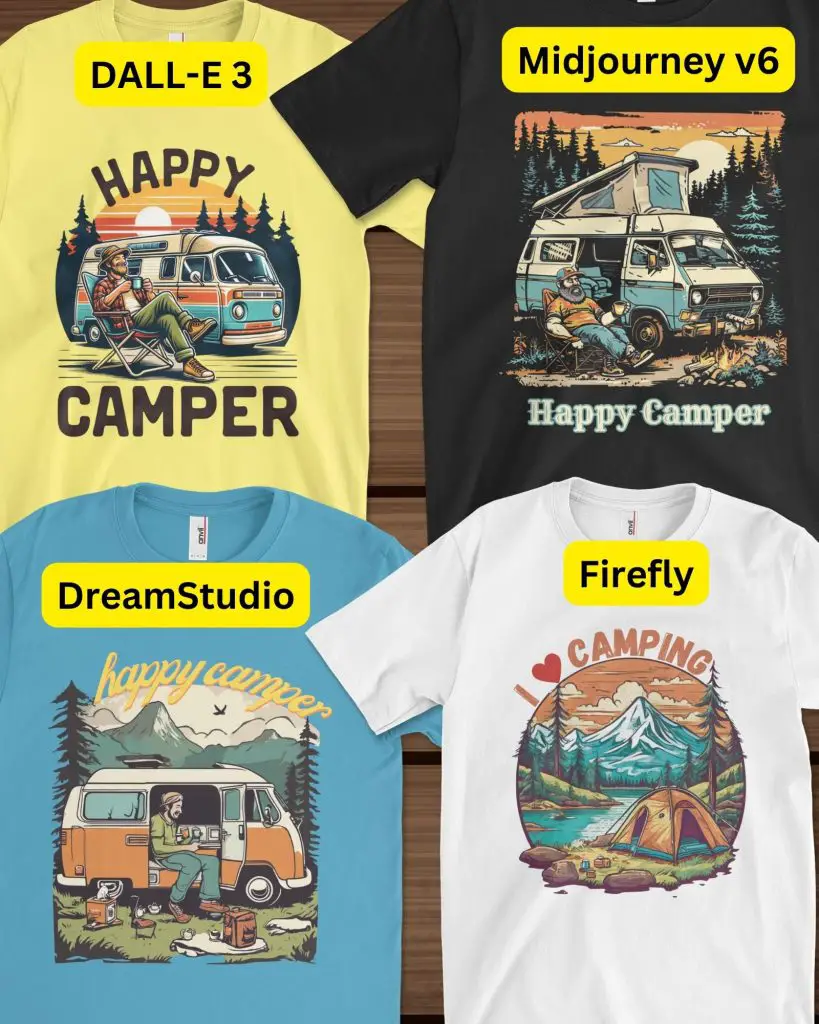
Dall-E 3, Midjourney, and DreamStudio all produced fairly comparable results. Now you might be wondering, why Adobe Firefly v2 is showing something completely different.
Well, actually, I had to completely change the prompt to get something that would work as a T-shirt graphic. You see, Adobe Firefly has a tendency to produce images that extend to the edges of the canvas and don’t finish.
This is what I mean:

See how the images are all cut off at the edges? It happens when you give it more detailed prompts. By contrast, with the right prompting the other 3 image generators seem to understand that I want a graphic that doesn’t get cut off at the edges.
Winner: Dall-E 3 (ChatGPT)
While Midjourney and DreamStudio (Stable Diffusion) also did well, OpenAI’s Dall-E 3 produced the best framing for the image. As a bonus, it wrote the text for me as well, with no spelling errors.
2. Gardening Niche
I had gardeners in mind for the next design.
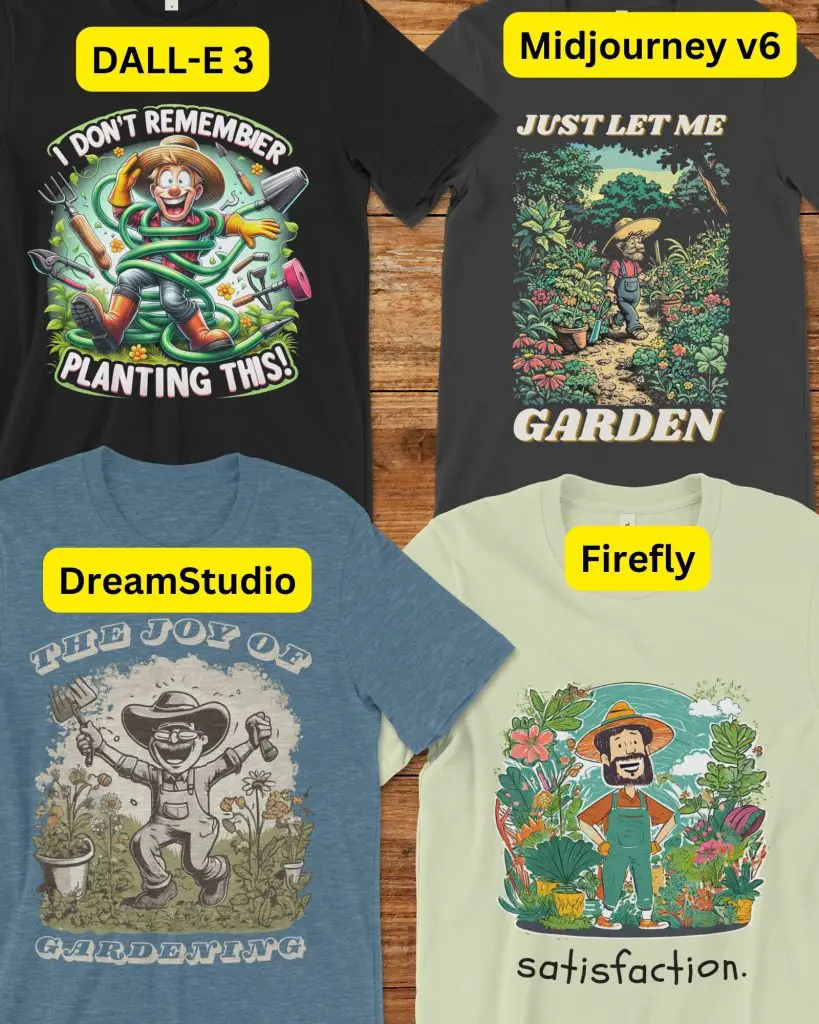
While Dall-E 3 produced a fairly average graphic for my original “man in garden”-type prompt, telling it to come up with something funny produced much more interesting results. In fact, it definitely came up with something better than I could! And therein lies the power of ChatGPT, it can even replace the need to actually think up a design.
Winner: Dall-E 3 (ChatGPT)
I really liked the Midjourney illustration, but with the help of ChatGPT Plus, Dall-E produced a humorous design on its own complete with (albeit slightly misspelled) text.
3. Books Niche
Next up, an image that shows the ability of books to transport readers into other worlds.
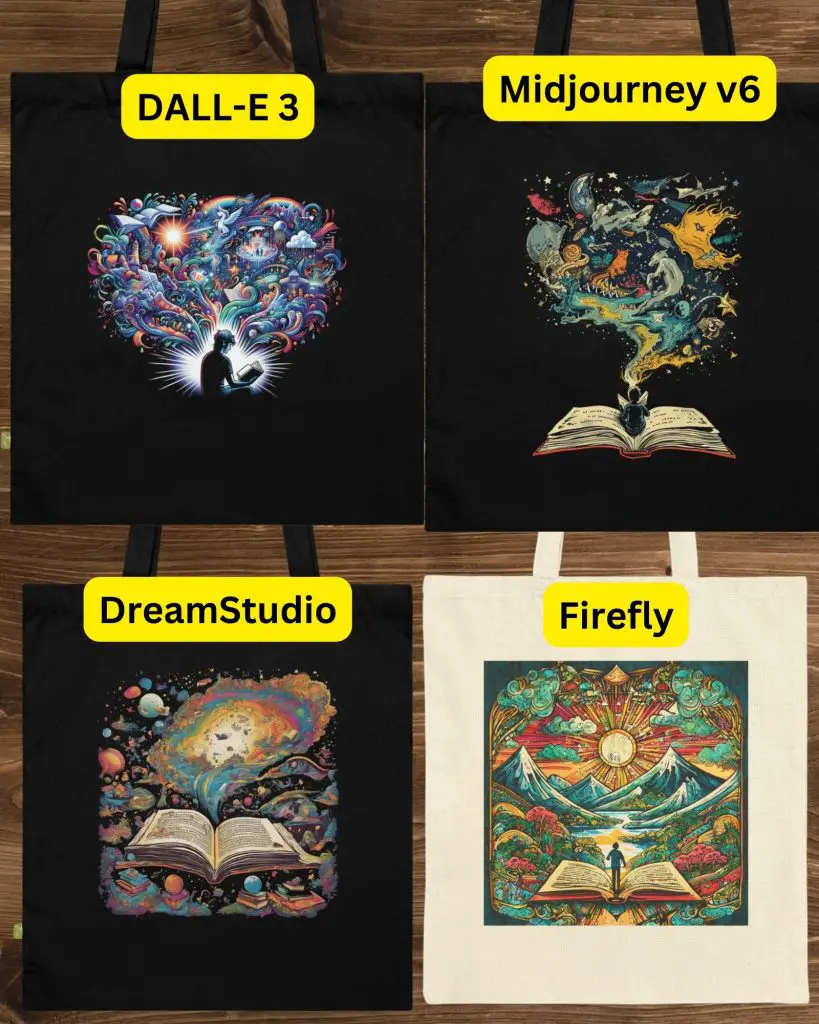
Winner: Midjourney v6
OpenAI’s Dall-E 3 produced the image that most accurately reflects the design idea, but Midjourney produced the most aesthetically pleasing design.
DreamStudio also produced something nice, but the graphic was less coherent and lacking a figure of the reader.
Finally, I liked the art style of the Adobe Firefly’s generated image, but it didn’t capture the idea of a book opening up portals to multiple other worlds, instead showing just one world.
If you want to learn how I quickly prompt consistent images across platforms, make sure to subscribe to my newsletter and I’ll instantly share a neat little trick with you!
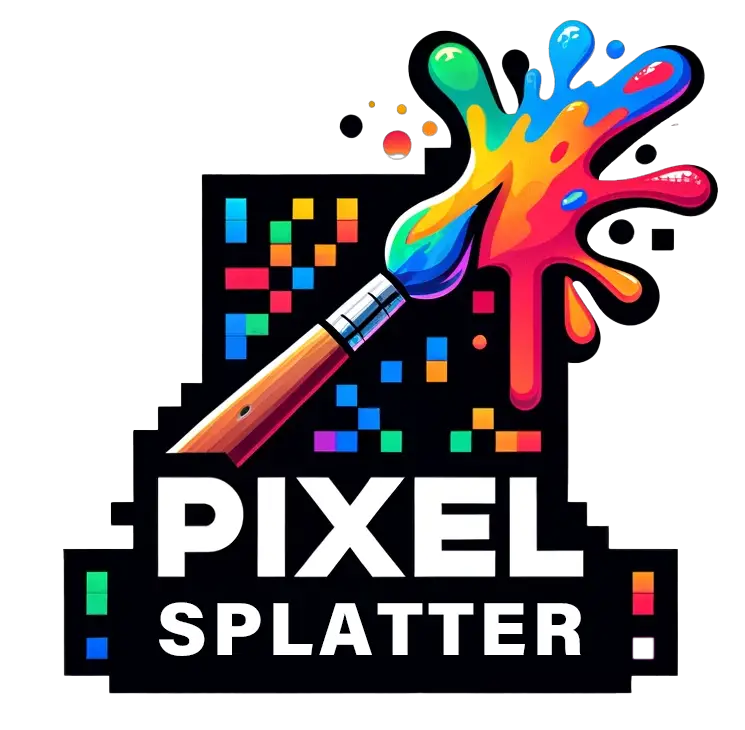
Pixel Splatter Newsletter
Stay up-to-date with the latest trends and techniques in AI-generated art for your print-on-demand business.
4. A Royal French Bulldog
Pets are a popular print on demand niche, and as an owner of two Frenchies I wanted a design that imagined one looking rather “royal” in an art nouveau style.
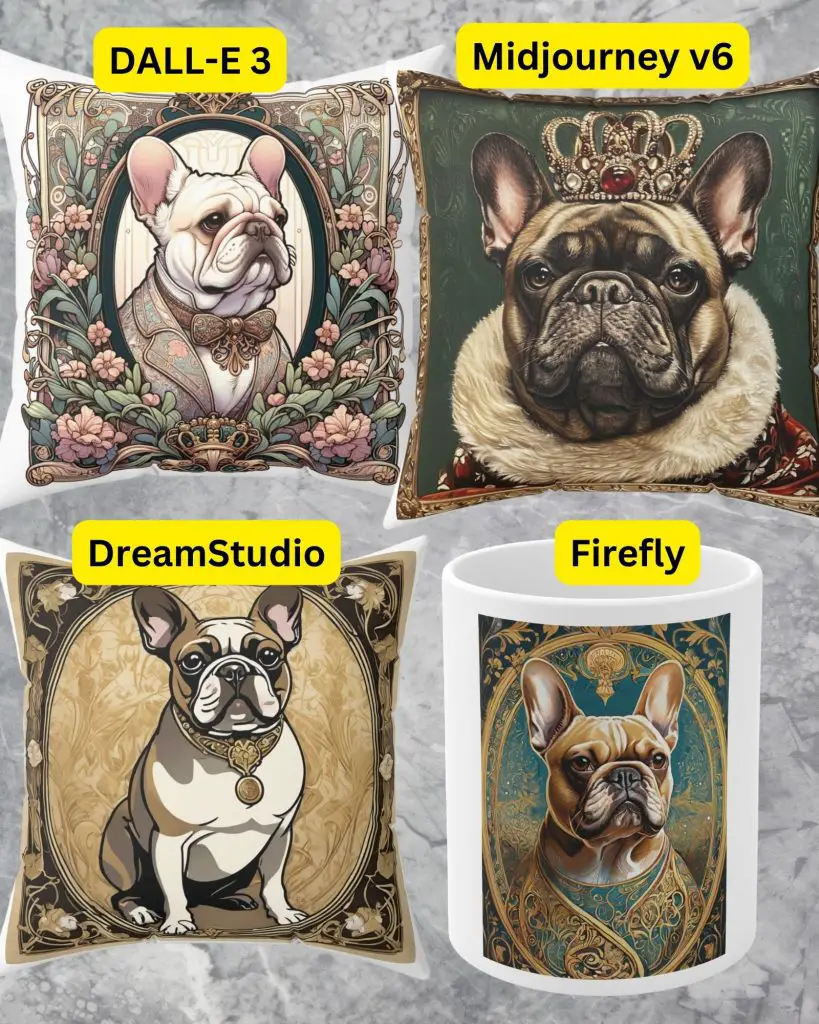
Winner: Midjourney v6
This one is up for debate, but I was most fond of Midjourney’s creation. As is usually the case, Dall-E 3 produced the best framing, while Stable Diffusion (DreamStudio) probably got closest to the art nouveau style I had in mind.
5. Land of the Free
Patriotic merchandise is very popular, so I went on to create a design that mixes the American flag with the bald eagle.
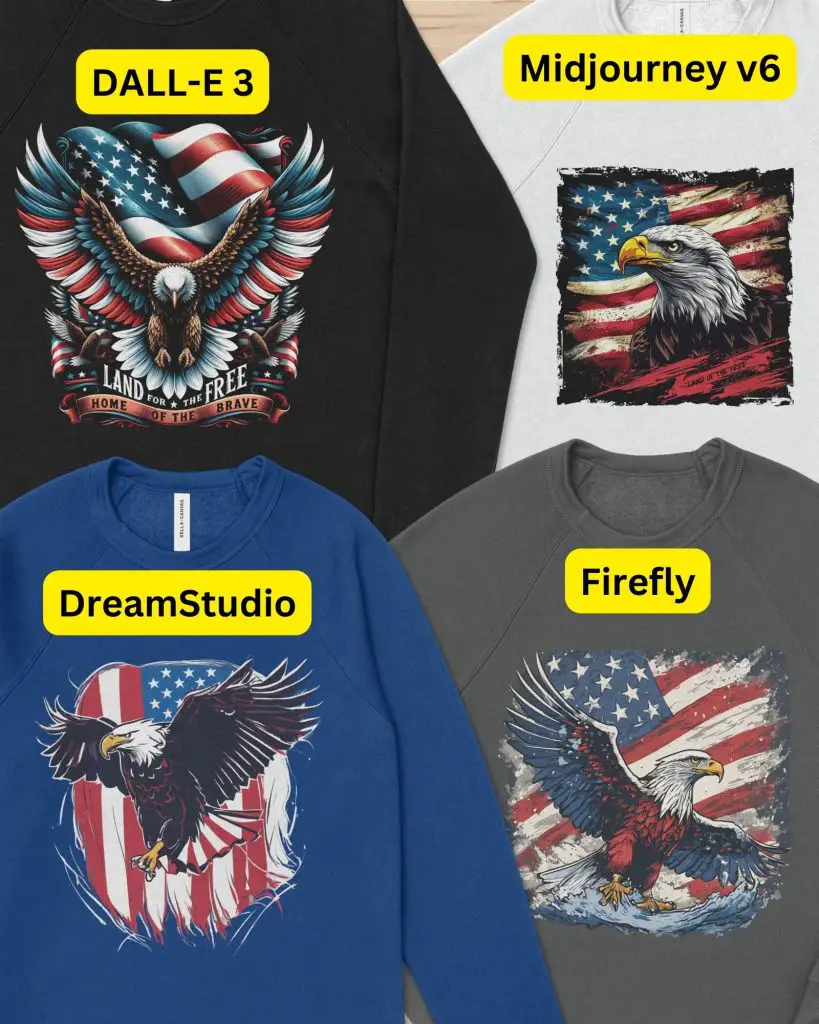
Winner: Dall-E 3 (ChatGPT)
Dall-E 3 was just on another level here, producing a visually striking graphic complete with text in one shot.
6. “Surveillance State”
I went with something a bit more abstract for the last comparison—a Baushaus style imagining of a surveillance state. While niche-specific or humorous graphics have traditionally been the most successful sellers in print on demand businesses, that was mostly because very few of us have the artistic chops to create artsy stuff.
I do think the ability to now create artsy stuff will mean we’ll continue to see more AI-generated “art” hitting platforms like Etsy.
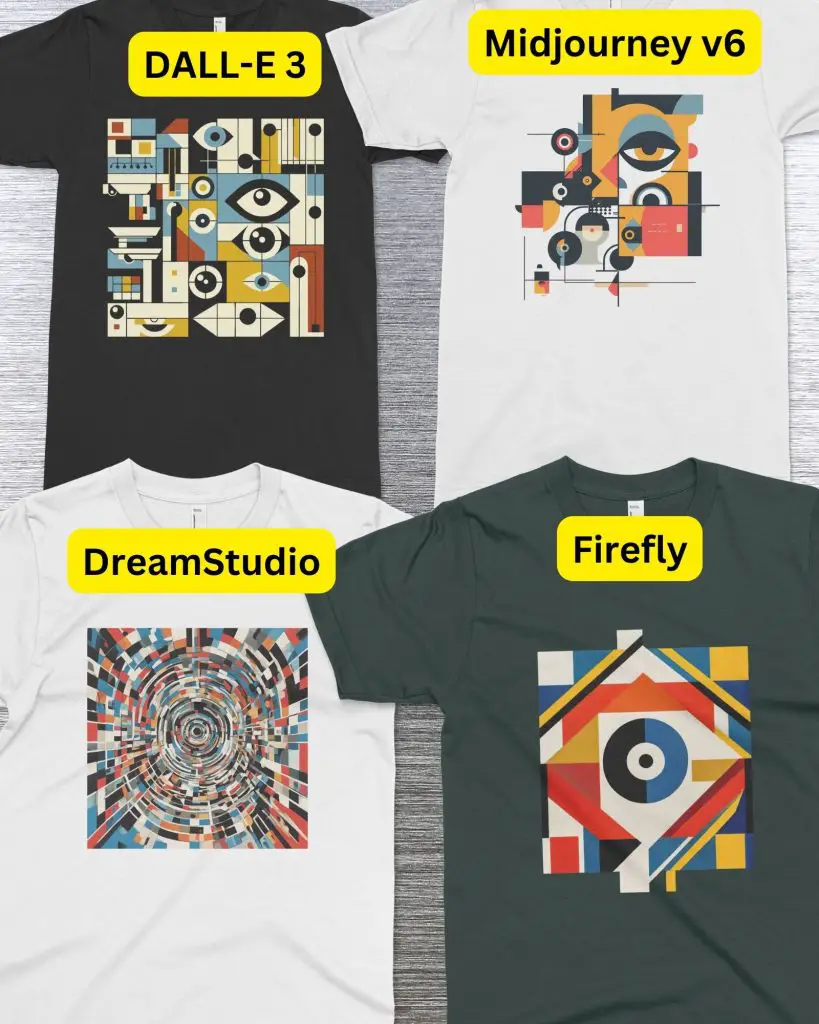
Winner: Midjourney v6
This was a bit of a toss up between Midjourney and Dall-E 3, but Midjourney came up with a more freeform shape, whereas Dall-E produced something quite square, which doesn’t look as good on a T-shirt.
Stable Diffusion produced the most unique image, although I really would have liked it to produce a complete image that wasn’t cut off at the bounds. Adobe Firefly v2 disappointed me, with the least interesting and thought-provoking image.
The Results
Tallying up the scores from the five comparisons gives us:
- Dall-E 3 (ChatGPT): 3 pts
- Midjourney v6: 3 pts
- DreamStudio (Stable Diffusion): 0 pts
- Adobe Firefly: 0 pts
Overall, if you’re thinking about selling merchandise with AI-generated designs, a subscription to ChatGPT Plus and Midjourney is all you need.
Dall-E 3
Dall-E 3 is easily the most capable when it comes to being able to follow instructions and reproduce smaller details. It can often one-shot designs, meaning you don’t have to do any editing yourself (although I always recommend to).
However, while it is the smartest text-to-image generator out there, it is one of the least flexible. Most notably, images are rendered in 1024×1024 resolution, which is not ideal for print on demand.
The answer to the problem is, you guessed it, more AI, specifically AI image upscalers. I plan to publish another post on this exact topic soon.
Midjourney
Whereas ChatGPT and Dall-E 3 can often magically read your mind, prompting with Midjourney is a bit more of a struggle. And even with the best prompts, it often won’t recreate what you ordered it to.
However, it is much more flexible when it comes to parameters and giving you other options to tinker. Plus, it generates 4 images at a time, and has a built-in image upscaler.
DreamStudio and Adobe Firefly
DreamStudio and Adobe Firefly weren’t bad, but they just didn’t do anything special that makes them worth having on top of the above two.
DreamStudio still felt a bit behind. I think the true power of Stable Diffusion models lie in the ability to train them with your own images. However, this is a bit more advanced, and is not possible through the Stability AI’s DreamStudio interface.
Adobe Firefly v2 also has some interesting tricks up its sleeve, which I didn’t get round to playing around with. There’s the ability to adjust the visual intensity, and various sliders to change visual effects. However, it’s all stuff that eventually gets translated to text prompts.
Of course, keep in mind that this is all in the context of print on demand graphics. For different uses like photorealistic imagery or digital art, the rankings could very well differ.
What did you think? Let me know in the comments below!
